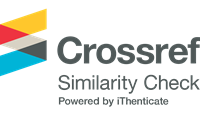Mechanisms for the formation of empathic culture of students of pedagogical and medical universities
Abstract
The relevance of this study is caused by the insufficient methodological development of the mechanisms and methods for the empathy formation among students of pedagogical and medical universities, which is an important professional competence of future teachers and doctors. The empathic culture of teachers and doctors is an integral part of the personal culture, a component of profession skill that requires purposeful formation and development. The purpose of the study is to theoretically substantiate and experimentally test the mechanisms of formation of the empathic culture in students of pedagogical and medical universities. The main research method is based on the selected diagnostics: 1. The method of diagnosis of communicative control (M. Schneider); 2. Assessment program of non-verbal communication (A.M. Kuznetsova); 3. Methodology ‘Balanced Emotional Empathy Scale’ (A. Mehrabian, E. Epstein). Results. In the profession of a doctor and teacher, we have demonstrated that empathy is an important professional quality. The majority of students of pedagogical and medical universities showed average levels of empathic culture. Emotional and activity channels of empathy are more developed among teachers, and cognitive channels are more developed among physicians. Practical significance. The results of the study can be used in the professional training of students of pedagogical and medical universities.
Downloads
References
Chen, X., Zhang, Y., Xu, X., Wang, W., Yan, H., Li, S., & Yang, N. (2019). Mediating roles of anxiety, self-efficacy, and sleep quality on the relationship between patient-reported physician empathy and inflammatory markers in ulcerative colitis patients. Medical Science Monitor, 25, 7889-7897. DOI: https://doi.org/10.12659/MSM.917552
Dolgova, V. I., & Melnik, E. V. (2014). Empathy. Moscow, RU: Pero Publishing House.
Fetiskin, N. P., Kozlov, V. V., & Manuilov, G. M. (2002). Methods of expert assessment of non-verbal communication. In Social and psychological diagnostics of personality development and small groups (p. 120-121). Moscow, RU: Institute of Psychotherapy
Friedemann, M. H.-H. O. (2013). Kriterien-basierte Beurteilung der Anamnesequalität und Empathiefähigkeit von PJ-Studierenden in Hamburg (Dissertação de Mestrado). Universität Hamburg, Hamburg.
Garnett, S., Dambha-Miller, H., & Stuart, B. (2020). Quantifying empathy levels among UK undergraduate medical students: an online survey. British Journal of General Practice, 70 (Suppl. 1), bjgp20X711293. DOI: https://doi.org/10.3399/bjgp20X711293
Geffrey, D. (2017). Communicating with a human voice: developing a relational model of empathy. Journal of the Royal College of Physicians of Edinburgh, 47(3), 266-270. DOI: https://doi.org/10.4997/JRCPE.2017.312
Haque, M. (2020). Empathy among medical students is an essential requirement to be a respectable and holistic medical doctor. Bangladesh Journal of Medical Science, 19(3), 355-357. DOI: https://doi.org/10.3329/bjms.v19i3.45849
Ilyin, E. P. (2013). Emotions and feelings (2nd ed.). St. Petersburg: Peter.
Jung, С. (1996). Psychological types. Moscow, RU: University book.
Kanchan, T., & Krishan, K., & Dehal, N. (2018). Quality of medical education: is our health in safe hands? Indian Journal Medical Ethics, III(3), 259. DOI: https://doi.org/10.20529/IJME.2018.021
Kohut, H. (2000). Introspection, empathy, and psychoanalysis: a study of the relationship between mode of observation and theory: an anthology of contemporary psychoanalysis. Moscow, RU: Institute of Psychology of the Russian Academy of Sciences.
Krishnasamy, C., Ong, S. Y., Loo, M. E., & Thistlethwaite, J. (2019). How does medical education affect empathy and compassion in medical students? A meta-ethnography: BEME Guide no. 57. Medical Teacher, 41(11), 1220-1231. DOI: https://doi.org/10.1080/0142159X.2019.1630731
Kuznetsova A. M. (2002). Methodology of expert evaluation of nonverbal communication / Social and psychological diagnostics of development of personality and small groups. - М., 2002. C.242-244.
Lermen, C., Wetzel, W., Britz, V., Sterz, J., Bechstein, W., & Schreckenbach, T. (2022). Empathy, personality traits, and emotional management in 2nd and 4th-year dentistry students: a single-center study. BMC Medical Education, 22(2). DOI: https://doi.org/10.1186/s12909-021-03080-1
Lipps, T. (1907). Guide to psychology. St. Petersburg, RU: O. N. Popov Publishing House.
Nemov, R. S. (1999). Fundamentals of psychological counseling: Proc. for stud. Of pedagogical universities. Moscow, RU: Publishing Center VLADOS.
Omid, A., Haghani, F., & Adibi, P. (2018). Emotional intelligence: an old issue and a new look in clinical teaching. Advanced Biomedical Research, 7(1), 32. DOI: https://doi.org/10.4103/2277-9175.225926
Podlasy, I. P. (2004). Pedagogy of elementary school: textbook for stud. pedagogical schools and colleges. Moscow, RU: Publishing Center VLADOS.
Professional standard of a teacher. (2013). Bulletin of Education, 8. 4-44.
Rogers, C. (1994). A look at psychotherapy. The formation of man: a monograph. Moscow, RU: Progress.
Rogers, C. R. (1975). Empathic: an unappreciated way of being. The Counseling Psychologist, 5(2), 2-10. DOI: https://doi.org/10.1177/001100007500500202
Shapiro, J., Morrison, E., & Boker, J. (2004). Teaching empathy to first year medical students: evaluation of an elective literature and medicine course. Education for Health (Abingdon), 17(1), 73-84. DOI: https://doi.org/10.1080/13576280310001656196
Shkitina, N. S., Elagina, V. S., & Nemudraya, E. Y. (2014). Future teachers empathy training. Modern Problems of Science and Education, 3.
Schneider, K. (1999). Clinical psychopathology (Transl. from German). Kiev: Sphere.
Simonova, Z. G. (2013). Medical humanities in the process of training of future doctors as a means of overcoming the problem of dehumanization of medicine in the XXI century. Modern Problems of Science and Education, 3.
Sinyagina, N. Y. & Derkach, A. A. (1998). Socio-perceptive characteristics of the teacher's personality. Development of social-perceptual 180 competence of the individual: materials of the scientific session dedicated to the 75th anniversary of A.A. Bodalev. Moscow, RU: Luch.
Sobczak, K., & Popowicz, B. (2019). The analysis of the empathy factor in students of medical sciences. Polish Annals of Medicine, 26(2), 145-150. DOI: https://doi.org/10.29089/2019.19.00079
Yu, C. C., Tan, L., Le, M. K., Tang, B., Liaw, S. Y., Tierney, T., … Low, J. A. (2022). The development of empathy in the healthcare setting: a qualitative approach. BMC Medical Education, 22, 245. DOI: https://doi.org/10.1186/s12909-022-03312-y
Zakharova, E. A., Ezhova, Y. M., & Rakov, N. A. (2019). Empathy as a basis for doctor-patient communication: current state of the problem. Psychology. Historical-critical Reviews and Current Researches, 8(3A), 119-138.
Zhou, Y. C., Tan, S. R., Tan, C. G. H., Ng, M. S. P., Lim, K. H., Tan, L. H. E., … Krishna, L. K. R. (2021). A systematic scoping review of approaches to teaching and assessing empathy in medicine. BMC Medical Education, 21, 292. DOI: https://doi.org/10.1186/s12909-021-02697-6
Zimina, N. A. (2015). Psychological diagnostics of personality's communicative potential: guidelines for students. Nizhny Novgorod, RU: Nizhny Novgorod State University of Architecture and Civil Engineering.

This work is licensed under a Creative Commons Attribution 4.0 International License.
DECLARATION OF ORIGINALITY AND COPYRIGHTS
I declare that this article is original and has not been submitted for publication in any other national or international journal, either in part or in its entirety.
The copyright belongs exclusively to the authors. The licensing rights used by the journal are the Creative Commons Attribution 4.0 (CC BY 4.0) license: sharing (copying and distributing the material in any medium or format) and adaptation (remixing, transforming, and building upon the material thus licensed for any purpose, including commercial purposes) are permitted.
It is recommended that you read this link for more information on the subject: providing credits and references correctly, among other crucial details for the proper use of the licensed material.













































